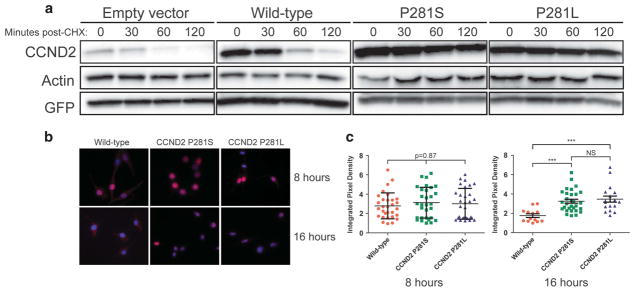Figure 1.
CCND2 P281 variants are resistant to degradation and nuclear export. (a) Protein extracts from NIH-3T3 cells stably expressing each construct (top labels) were treated with cycloheximide (CHX) and were analyzed by western blotting using an antibody against CCND2. The wild-type CCND2 construct shows clear protein reduction by 60 min post-CHX treatment, while mutant constructs show relatively stable levels of protein, even by 120 min post-CHX treatment. (b) Representative immunofluorescence images of NIH-3T3 cells stably expressing either wild-type or CCND2 P281 variants. Cells were serum starved for 20 h in RPMI containing 0.1% FBS, reintroduced to serum, and then collected for immunofluorescence analysis at the specified time points post-serum reintroduction. Eight hours and 16 h post-reintroduction were chosen as collect time points because they represent time points at which the majority of wild-type CCND2 is nuclear and cytoplasmic, respectively. Red =CCND2, blue =DAPI. (c) Quantification of mean pixel density in the nucleus to establish nuclear localization of CCND2 constructs. At least ten cells were analyzed for each condition. ***P<0.0001 by one-way ANOVA and subsequent Tukey’s post hoc tests. Error bars show s.d.

